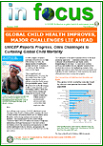|
A family year - a 5-part multilingual television series
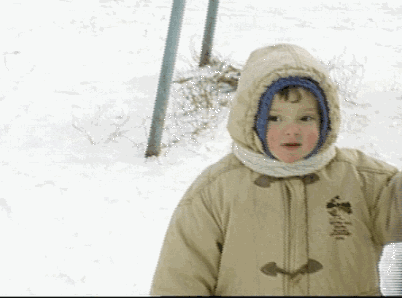
Czech child born during the filming of A Family Year
The Center for Communications, Health and the Environment (CECHE) has developed a 5-part television series focusing on the health and environmental threats facing families in Russia and Central Europe-a topic of concern to both audiences worldwide. Entitled A Family Year, the series invites viewers into the lives of families in Russia, Hungary, Poland and the Czech Republic. Using the human drama of family life as the backdrop, A Family Year is based on formative research by media and health professionals from both sides of the Atlantic. This international team has created a multi-cultural framework for an uncompromising study of human beings struggling to cope with challenges to their personal health or environment. Each episode in this series provokes public discussion, enhances public understanding of health and environmental issues, encourages individuals to make lifestyle changes that reduce risks and decision makers to better shape future public health and environmental health programs. 
Polish food store displays fat and salt laden sausage
To date, the series has been broadcast on national television channels in 17 countries in Central Europe and the Newly Independent States to a potential audience of over 300 million people and scheduled for broadcast in several others. These include NOVA TV, in the Czech Republic, Internews in the Newly Independent States (covering 12 countries) and MTV in Hungary. Telewizja Polska in Poland, PopTV in Slovenia, TV Markiza in Slovakia, Gravis TV 35 in Ukraine, and PRO TV in Romania are scheduled to air the program later this year. Evaluation is being coordinated by Dr. Fiona Chew of the Newhouse School at Syracuse University in New York. The data for viewer response in Hungary shows that over a million and a half people tuned in to the Family Year series last winter-that figure translates to roughly a third of the total viewing audience. Preliminary analysis of viewer interviews shows that 89% would like to see more such programming. Overall, 16-38% of the viewers reported making a positive lifestyle change within 6-12 months after viewing the series. A Family Year was filmed in an intimate way so that viewers could get to know and identify with the individuals and families featured in each episode. Coming from different nations and from vastly different socioeconomic backgrounds, these families provide a fascinating panorama for the delivery of health and environmental health messages within a spectrum of dramatic, humorous entertaining and emotional family situations. Because health and the environment are closely related to lifestyle and income, the series portrays many different aspects of family life in each country. Through the illustration of key issues, self-help measures and carefully targeted intervention in the lives of the families, the series attempts to inform, educate, and stimulate changes in knowledge, attitudes and behavior. Each 27-minute episode focuses on one or two related issues (e.g. lifestyle and other environmental factors and disease, cigarette smoking and alcohol abuse, diet and prevention of chronic illness, maternal and child health, health impact of environmental pollution) and features illustrative examples from each participating country. 
Polluted lake in Poland source of concern to citizens
The series shows how peoples' health can be brought much more under their own control than they realize. In societies where medical care is often under-staffed and deprived of the latest resources, the focus of medical care will have to switch to the family-to child care, family nutrition, and a responsible attitude towards smoking, alcohol and drugs. In this series we meet four ordinary families and follow them over the next six months as they talk to us about their views on health, nutrition, smoking and child care, and try to put into practice some of the measures that could prevent them and their children from developing some of the major diseases of our time. 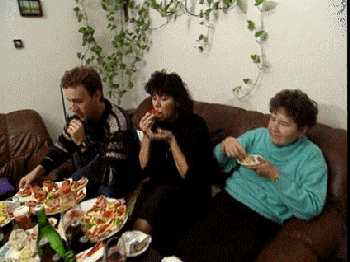
The Davidek family screens the first program of A Family Year
The families we have chosen for this series cover a range of incomes, occupations, and structures, from the young Czech parents looking forward to the birth of their first child to the middle-aged Russian couple concerned about the health of their young granddaughter. There are also three generations of Polish women living under one roof, trying to cope without husbands in the urban sprawl of Warsaw, and a Hungarian family with two teenage children surrounded by the temptations of a fast-Westernizing society. We film these families at work and at play; we discuss their preoccupations and concerns, not just about health but about money, crime, and pollution; and with the unobtrusive help of health promotion experts in each country we look at the way they lead their lives and suggest changes that they might carry out during the period of our filming. By watching this series the audience is made aware of some of the things they can do for themselves and their children to lead to a healthier future. But it is also an entertaining and intriguing series, as the viewers get a rare glimpse into the everyday lives of people like themselves, struggling with the same problems and facing the same challenges. Formative Research A single TV series was developed for use throughout Central and Eastern Europe on the assumption that the common experiences in this region, particularly during the decay of the health infrastructure, would result in a common understanding of health concerns, goals, approaches, resources and priorities and resources. Therefore, formative research comprising surveys of public opinion in these four countries were conducted among three population groups -- the general public, health experts and media professionals. Formative research was conducted to maximize the educational and motivational effects of the television series and to ascertain the major health issues of concern in each of the four participating countries. It also served as a basis for assessing the impact of the series. 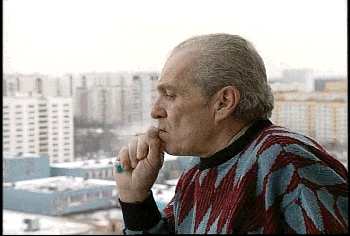
Russian smoker contemplating giving up smoking under A Family year team guidance
Cardiovascular disease, cancer, obesity, and injuries were identified as health issues of special interest in all four countries. Inequality in health and accessibility of health services was of concern in Hungary, while poor health services was considered a major problem in Russia. Furthermore, poor diet, lack of physical activity, and alcohol abuse were the most frequently mentioned risk factors in all four countries. Environmental pollution was a key factor identified by Russians and Czechs. Values deemed important by all population groups included economic welfare and good health. The topics suggested for programming included all health issues in Russia; health, diet and slimming, diet risks, physical activity and injuries in Poland; health, diet and slimming, diet risks, and psychological aspects of health in the Czech Republic; and dissatisfaction with the health system in Hungary. Health and media professionals stressed that social aspects of health should be included in health programming. Finally, in all four countries, there was a strong interest in obtaining practical advice. Evaluation Of Impact 
Viewers report a positive change in lifestyle six to twelve months after viewing A Family Year
A Family Year appears to have had a significant impact on the viewers in Russia and Central and Eastern Europe. The following are the highlights:
In an assessment of actual lifestyle change three months to a year after the television series was broadcast (see bar graph on next page), the Hungarian viewers led the way with the highest proportion (38%) indicating that they had made a positive chan e in their lifestyle in accordance with the recommendations in A Family Year. This was followed by Russians (34%), Poles (21%) and the Czechs (16%).
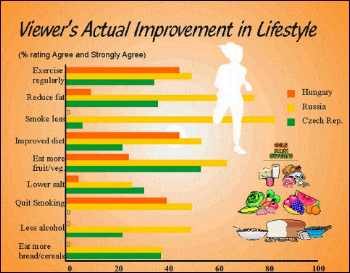
Viewers report specific lifestyle changes after following A Family Year
Comment A Family Year met its primary goal by enhancing the knowledge and motivation of Central and Eastern European viewers to improve their lifestyle through providing "useful and practical information" from reliable sources. The differences in general impact of the program series among the different countries can be attributed to differences in broadcast channels and demographic differences such as age and education levels among viewers. The extent of reported lifestyle changes among the Central Europeans surveyed compare highly favorably with and indeed far exceed the results of similar health communication efforts reported among American television viewers. In the seminal Stanford Three-Community Studyconducted in 1973, the community tht was exposed only to the 8-month mass media campaign (television, radio and print) experienced a mere 3% decrease in cigarette smoking, 2% reduction in heart disease risk and 0.5% reduction in cholesterol level. In the national survey of viewers of "Feeling Good" an 11-part television series of one hour programs broadcast on the Public Broadcasting Service from November 20, 1974 through January 29, 1975, no differences were found in dietary behavior practices three months after the series broadcast. The higher impact in this region compared to the United States probably reflects several factors: first, that American audiences are far more exposed to well conceived health programming than Central Europeans, who are generally confronted with "talking heads shows" and are thus a captive audience for good programming and much more likely to be amenable to suggested change through well produced television programs. A Family Year is among the first such efforts to use television for positive health impact in the region. Second, A Family Year measured short- and medium-term change, which is likely to show higher gains than long-term sustained change as measured in the Stanford study. The impact of A Family Year is comparable to CECHE’s Eat Smart PBS special show which aired in September 1991, and which also measured short-term change and showed substantial gains among American audiences. Third, CEE-NIS audiences, starting out from a lower knowledge base on health and environmental issues and less saturated with health programming are much more likely than well-informed American audiences to seek practical knowledge and to show larger gains. This also suggests that integrating health programming into daily TV schedules might at present have a greater potential impact in CEE-NIS than in the US to inform and motivate audiences to improve their lifestyle and eventually their health. Recommendations The following recommendations derive from comments of the viewers as well as the CEE-NIS research team.
Interested in purchasing A Family Year TV Series? Click here. Click here to view related report on The Communication Initiative website. |
|
|||||||||||
Questions? Comments? Concerns? E-mail CECHE at CECHE@comcast.net Go back to the CECHE home page Go back to the CECHE home page
|

